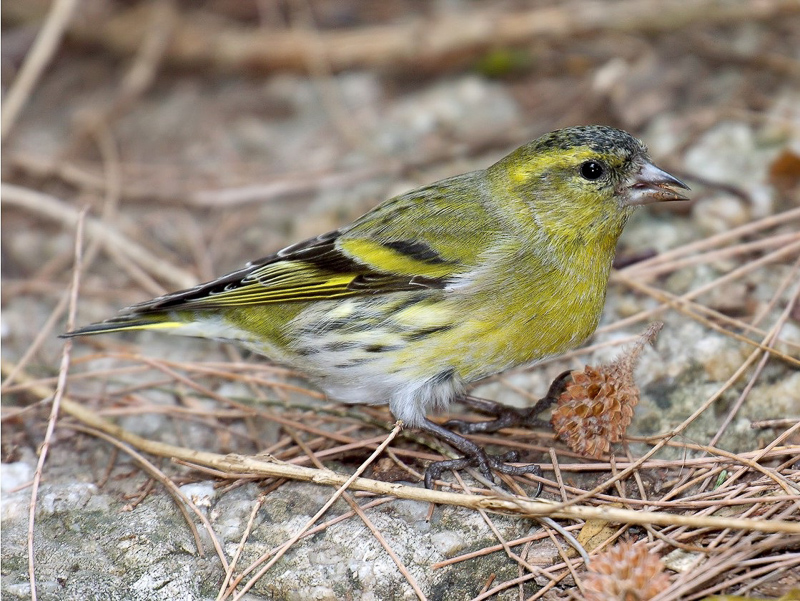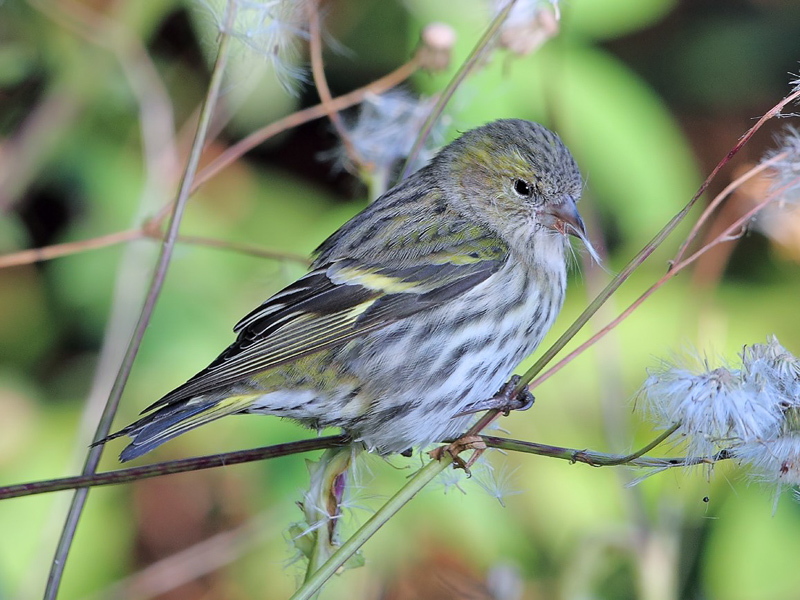Eurasian Siskin Spinus spinus 黃雀
Category I. Rare migrant and winter visitor prone to irruptive influxes. Wintering birds occur in mature secondary forest.
IDENTIFICATION

Nov. 2007, Michelle and Peter Wong. Male.
11-12 cm. Compact finch with relatively long, conical and pointed bill and short tail. In flight shows distinctive dark wings and broad yellow wing bar, rump and sides to tail. Male has dark crown and bib, plain yellowish rear of face and limited streaking on chest.

Oct. 2010, Michelle and Peter Wong. Female.
Female is more streaked, less yellow and lacks blackish on the head.
VOCALISATIONS
A vocal species, especially in flocks when birds may maintain a constant chatter.
The flight call is often disyllabic, the second syllable differing in pitch from the first.
DISTRIBUTION AND HABITAT PREFERENCE
Eurasian Siskin is most often observed in larger trees, and thus it favours mature forest such as that on the Tai Mo Shan massif (especially Tai Po Kau and Shek Kong Catchment). However, it has also been recorded at such diverse sites at Po Toi, Cheung Chau, Au Tau near Yuen Long, Mai Po NR and Discovery Bay.
OCCURRENCE
Figure 1 illustrates the pattern of occurrence from 1999 to 2020. Extreme dates are 13 October 2012 and 4 May 2014. On Po Toi, where it seems only migrants occur, it has been recorded from 13 October to 24 November and on 2 April and 4 May.
Eurasian Siskin was first recorded in HK in 1973 when a flock of 30 were present at Tai Po Kau from 13 January to 20 February. Subsequently, it was recorded in three winter periods in both the 1980s and 1990s, including a sizeable influx in winter 1990/91 when at least 138 birds were recorded at four sites in the New Territories.
The next record occurred in October 2005, but since then it has been recorded in most winters, albeit numbers vary considerably. Significant influxes occurred in winter 2010/11 and 2012/13. The latter began with a flock of 12 on Po Toi in October and November and was followed by up to 80 at Tai Po Kau (the highest single-site count on record) from 23 November to 14 February, up to 40 at Lam Tsuen and ten on Cheung Chau. Shek Kong catchment has proved attractive in recent years with flocks of up to 30 in January and February 2018 and March and November 2020.
BEHAVIOUR, FORAGING & DIET
Gregarious, often occurs in noisy flocks. Has been recorded feeding on seeds of pines Pinus sp., Horsetail Tree Casuarina equisetifolia, Japanese Alder Alnus japonica and Sweet Gum Liquidambar formosana. The large individuals of this last species in the lower parts of Tai Po Kau are particularly favoured.
RANGE & SYSTEMATICS
Monotypic. Breeds from north and east Europe east to southwest Siberia, and in southeast Siberia to the Sea of Okhotsk; winters south of Scandinavia in much of continental Europe to the Caspian Sea and China, the Korean Peninsula and Japan (Clement 2020). In China a summer visitor to limited areas of the northwest and northeast and winters in central and eastern parts as far north as Beijing (Birding Beijing 2022, Liu and Chen 2020).
CONSERVATION STATUS
IUCN: Least Concern. Population trend decreasing.
Figure 1.

Birding Beijing (2022). https://birdingbeijing.com/the-status-of-the-birds-of-beijing/ (Accessed 26 June 2022).
Clement, P. (2020). Eurasian Siskin (Spinus spinus), version 1.0. In Birds of the World (J. del Hoyo, A. Elliott, J. Sargatal, D. A. Christie, and E. de Juana, Editors). Cornell Lab of Ornithology, Ithaca, NY, USA. https://doi.org/10.2173/bow.eursis.01
Liu, Y. and Y. H. Chen (eds) (2020). The CNG Field Guide to the Birds of China (in Chinese). Hunan Science and Technology Publication House, Changsha.

